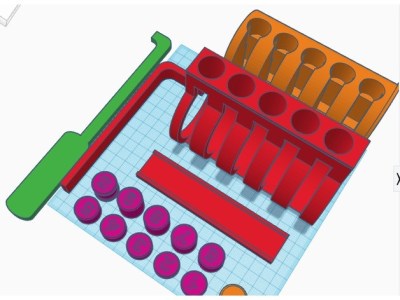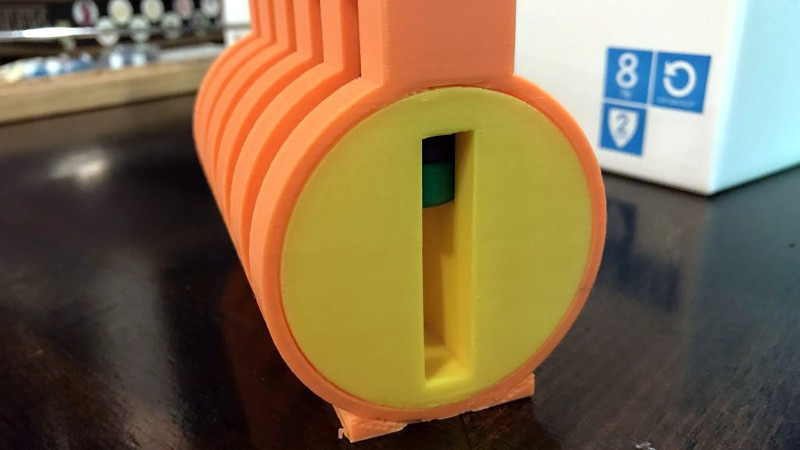Despite what the media might tell you, picking locks isn’t just for spies and guys wearing balaclavas. Those who pick as a hobby, or even competitively, think of locks as logic puzzles. Each lock is a unique challenge, and defeating it requires patience, dexterity, and perhaps most importantly the experience that comes from regular practice. But where does one start if they want to get into the world of recreational lock picking, also known as locksport?
 Many people begin their journey on a practice lock, usually made of clear plastic so you can see its inner-workings. That’s fine for the individual, but what if you’re trying to demonstrate lock picking to a group? [John Biggs] may have the solution for you, assuming you’ve got the time and material. His huge 3D printed cutaway lock, and appropriately sized tools, allow even the folks in the back of the room to see how basic picking techniques work.
Many people begin their journey on a practice lock, usually made of clear plastic so you can see its inner-workings. That’s fine for the individual, but what if you’re trying to demonstrate lock picking to a group? [John Biggs] may have the solution for you, assuming you’ve got the time and material. His huge 3D printed cutaway lock, and appropriately sized tools, allow even the folks in the back of the room to see how basic picking techniques work.
A print of this size is nothing to sneeze at; a quick peek on the reference printer here at the Hackaday Chamber of Secrets indicates you’re probably looking at the better part of 20 hours to print everything out. Once printed you’ll likely need to take a file and some sandpaper to all the surfaces to make sure things operate smoothly. It doesn’t appear to be a terribly challenging print all things considered, but we wouldn’t call it a beginner’s project either.
The only non-printed part in this design is the springs, which [John] mentions he hasn’t quite found the solution for yet. They need to be fairly weak or else the lock is too hard to pick, but springs large enough to work with the pins are usually pretty strong. This might be a perfect application for some custom wound springs.
After you’ve mastered the PLA lock, it might be time to make your own picks and see if anyone is giving free lock picking workshops in your area.
















Perhaps springs could be wound from warmed filament. I’ve even seen 3D-printed forms to get the spiral of filament springs just right.
They certainly don’t work out of laser cut acrylic!
I think 3mm filament would also be too much. 1.75mm might work, but gossip seems like you’d have to try different materials. Mostly, the plastics just snap after a few demonstrations.
Sand the pins lots & let gravity pull the pins down?
Does gravity pull everything in the direction you want it to go? If so then great!
Drill a hole in each one. Fill with lead, rocks, gravel or whatever is cheap, convenient and heavy. Then plug the hole with glue, abs juice, your favorite epoxy or whatever. (Yes, PVA juice does stick well to PLA when it dries, I have done this).
“Does gravity pull everything in the direction you want it to go?”
This is going to be a problem for all my dark matter acrylic. :P
Very cool lock! Good to see a few guys here from locksport.
I’ll have a look if I can get one printed for Toool NL. I’ve reposted this. :)
The headline photo seems obscene to me.
“Many people begin their journey on a practice lock, usually made of clear plastic so you can see its inner-workings.”
Reminds me of all those lock-picking mini-games.
What about using a smaller spring that has a larger 3D printed top and bottom section to adapt it to the right size so you can just use off the shelf, smaller overall diameter and smaller wire diameter springs?
For large, low strength springs, I have used bailing wire wrap-formed around a shovel handle. The bailing wire was higher strength than typical, so it had a bit of memory. Plain bailing wire deforms too easily. I also have one made from 14AWG copper that was wrapped around a pill bottle. For this situation, either may work adequately.
He should check out the springs used to hold in motorcycle oil filters — large diameter, small gauge spring wire…
Is it possible to try using foam rubber as a spring?
Many years ago, when I had a spring in the hub of the rear wheel of a sports bike, I used a piece of foam rubber for temporary replacement. I went about six months. Then came a cold winter and in frost impregnated with thick grease, foam stopped working as a spring. )))
I want to see the 3D printed key that fits that tumbler.